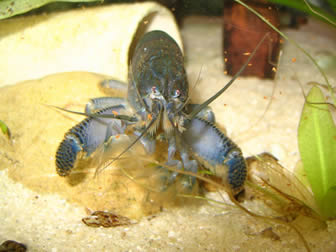Fan shrimp

Fan shrimp species Atya gabonnensis
Picture by nanaglen2001
Fan shrimp is a name commonly used for a large group of filter feeding shrimps. The group contains 15 different genera that combined contain about 160 different species. The most commonly kept genera in aquariums are Atyoida, Atyopsis and Paratya. Fan shrimps have claws that have developed into fine fans that allow them to filter small particulars out of the water to eat. They also use their “fans” to scoop up detritus from the bottom of the tank.
Fan shrimps are strict scavengers and will not hurt even the smallest aquarium inhabitants. This makes them the ideal cleaning crew for aquariums containing small fish and fry. They are very friendly and can be kept with almost any fish as long as they are big enough not to be considered food by the fish.
Different species of fan shrimp grow to different sizes but most species become between 1 inch and 6 inches (2.5 – 15 cm) in length. The preferred water conditions vary between different species and you should therefore always research the particular species you plan to keep before buying it.
Feeding fan shrimps is simple as they eat just about anything that is dead, but it is important to give them a varied diet containing both vegetable and animal matter. A good diet can for instance consist of different frozen foods and shrimp pellets. The fact that they are filter feeders might suggest that they only eat very small food items, but this is not true. They can eat larger food items by using their fans to lift the food to their mouth. I do however not recommend giving them food that is larger than mosquito larvae.
Many fan shrimp species can easily be bred in aquariums, but the triggers and desired conditions vary from species to species. The number of fry is usually small, seldom over 300 and often below 10. Once a mating has taken place the mother will carry the eggs until they hatch after approximately 28 days. The fry are hatched looking like miniature versions of the adults, but the coloration of the fry is very different from the parents to keep them camouflaged.
The fry grow very quickly and can be fed the same type of food as the adults; the food just needs to be smaller. The first 24 hours of the fry's life is critical and high fatality rates are common during this period. The fry will molt during their first 24 hours so you might find tiny empty shells from surviving fry. After two weeks, their survival chances increase drastically and fry older than two weeks will usually live to become adults. They get the coloration of the parents when they reach sexual maturity. Cannibalism is seldom a problem among fan shrimp fry and it is therefore usually not recommended to sort fan shrimp fry according to size.
